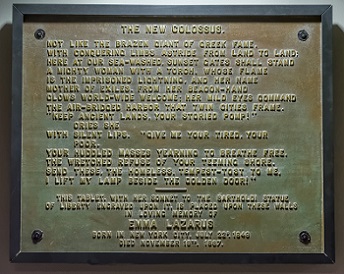Last updated: March 23, 2018
Lesson Plan
Interpreting A Symbol
Post Statue of Liberty Lesson Plan

- Grade Level:
- Upper Elementary: Third Grade through Fifth Grade
- Subject:
- Literacy and Language Arts
- Lesson Duration:
- 60 Minutes
- Thinking Skills:
- Evaluating: Make informed judgements about the value of ideas or materials. Use standards and criteria to support opinions and views.
Objective
At the end of the lesson, students will be able to:
-Describe several definitions that the Statue of Liberty has held over time.
-Explain the importance of Emma Lazarus’ poem as an example of how the Statue of Liberty has continued to bring meaning to different groups of people.
-Create their interpretations about the Statue of Liberty as the monument’s meaning evolves, past and present.
Background
The Statue of Liberty has held multiple meanings for different groups of people since its construction over 125 years ago. As symbols of welcome and freedom to its current messages of social justice today, the Statue of Liberty has served as an important icon to represent these causes.
Preparation
-Pen/Pencil
-Post-Its
-Large Silhouette Image of the Statue of Liberty
-Historic Images of the Statue
Materials
Download Interpreting A Symbol
Lesson Hook/Preview
This activity helps students explore the different meanings of the Statue of Liberty and help them develop their own interpretations for the monument today.
Procedure
1. Introduction (3 minutes) - Introduce to the group that the Statue of Liberty has held different meanings to different groups of people over time. Symbols take on a life of their own, and different people see different things and so the Statue of Liberty has many different meanings. Ask “What do you think the immigrants coming to America may have felt when they saw the Statue of Liberty for the first time?” and “What do you think the Statue of Liberty might have meant to a war hero coming home?” In general, ask the class “What does the Statue of Liberty mean to us today?” (Write down several of these buzz words on a white board. Later, these sample responses can be used to construct a sentence in the later activity).
2. Talk about some of the original intentions for the construction of the Statue of Liberty (5 minutes) - Inform the class that when the Statue of Liberty had been given as a gift from France, the United States had undergone massive social changes. The country had recently freed enslaved people; a group of abolitionists worked together to shape the message of social justice; women’s groups had started to demand for the right to vote. France had wanted to congratulate us for all the social improvements we had made to the country.
“Can anyone tell us a little about the Statue of Liberty? Who built it? This is a challenging question, but can anyone tell us why the Statue of Liberty was given to us?”
3. Introduce Emma Lazarus’s quote (5 minutes) – Ask students, “When you look at other the inspirations for the Statue, we find that famed poet Emma Lazarus wrote ‘Give me your tired, poor, and huddled masses’ which is now one of the best-known statements associated with the Statue of Liberty. ”What do you think that quote means?” or “What do you think the text says about what the Statue represents?” Ask for several student responses. (Print out the full version of Emma Lazarus’s “The New Colossus.”)
4. Create a Symbol or a Phrase to the Statue of Liberty (7-to-10 minutes) – After eliciting several student responses, invite students to pair in two-or-three, to create what phrase or symbols would they like to add to the Statue of Liberty today. Note: The teacher delivering the program should be sure to include a pre-filled symbol that they feel should be added to the Statue of Liberty to help the students get started.
“Let’s gather in small groups in 2013, and pretend to add something to the base of the Statue. What do you think the quote or list of words would include? Look back to when you first saw the Statue of Liberty? What did you think or feel? Let’s get specific onto what the Statue of Liberty means to us today. Thinking about some of these feelings, fill in the following responses: We are young Americans and the Statue of Liberty represents: …”
Teachers Note: Using a large piece of white paper, create a similar silhouette (next page) of the Statue of Liberty and place the enlarged recreation at the front of the class. Students can place their completed responses in the interior of the lined drawing. Alternative: Print out a silhouette copy of the Statue and have students write their responses on the sheets. That way, each student can share their responses to the class.
5. Pair-Share and Homework (5 minutes) – Invite students to share several of their responses about what the Statue of Liberty means to them today. At the end of the lesson, encourage the groups to think about how the Statue of Liberty’s meaning/message continues to change, and invite them to create their meaning. If interested, hand out the blank “Statue of Liberty newspapers” to students as a post-visit activity.
Vocabulary
Astride: in a posture of striding or straddling; with legs apart or on either side of something.
Beacon: a person or thing that illuminates or inspires.
Brazen: shameless or impudent.
Exile: anyone separated from his or her country orhome voluntarily or by force of circumstances.
Huddle: to gather or crowd together in a close mass.
Imprison: to confine in or as if in a prison.
Pomp: stately or splendid display; splendor;magnificence.
Refuse: something that is discarded as worthless oruseless; rubbish; trash; garbage.
Storied: recorded or celebrated in history or story.
Teeming: abounding or swarming with something, as withpeople.
Tempest: a violent commotion, disturbance, or tumult.
Wretched: very unfortunate in condition or circumstances; miserable; pitiable.
Yearn: to have an earnest or strong desire; long.
